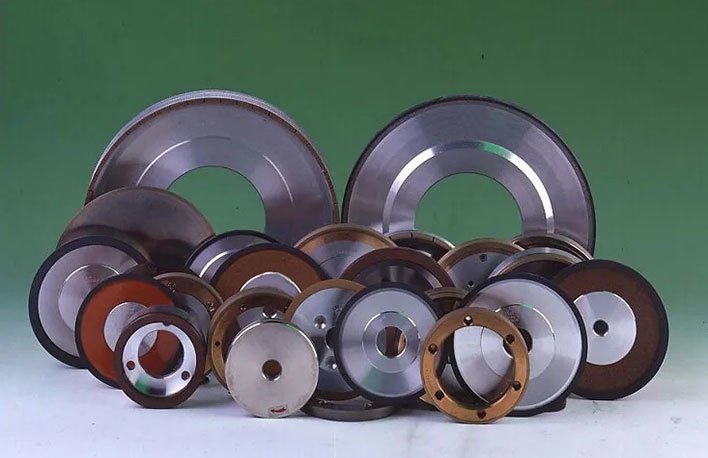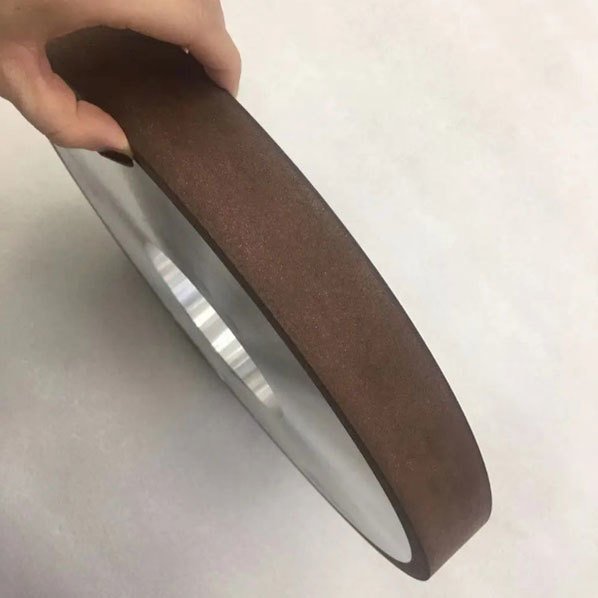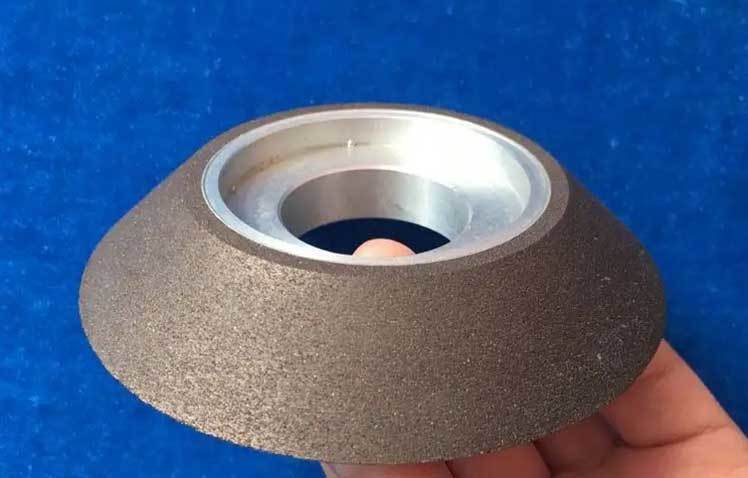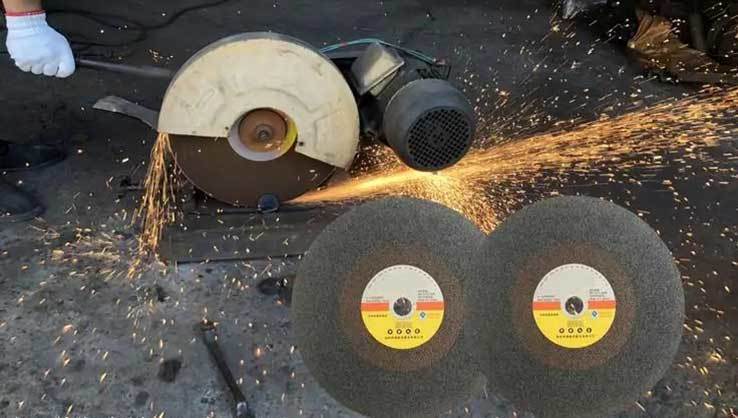Resin Bond Abrasive
1. Advantages and disadvantages of resin bond abrasive
1.1 advantages of resin bond abrasive
Resin abrasives refer to organic molecular compounds used as binders to consolidate aluminum oxide grit together to form a grinding tool with a certain rigidity.
1.1.1 High bonding strength.
Compared with ceramic bond, resin bond has high bonding strength, its linear grinding speed of resin grinding wheel is 80 ~ 120m / s, and can withstand large grinding pressure. The grinding load of heavy-duty grinding wheel has increased from about 50kg to more than 1000kg.
1.1.2 It has certain elasticity.
Compared with ceramic abrasives, resin Abrasives have good toughness, which is conducive to improving the finish of the processed workpiece. Selecting graphite, chromium oxide and other polishing materials as fillers can further reduce the roughness. At the same time, due to certain elastic deformation, it can buffer the effect of grinding force. Therefore, the grinding effect is good, the polishing effect is good, and the roughness of the machined surface can be improved.
There is a certain plasticity and ductility. Its elastic modulus (E) is several times lower than that of ceramics. Therefore, resin abrasives are suitable for preparing various specifications of thin-film grinding wheels and high-speed cutting grinding wheels. Because the resin has good molding properties and good toughness, it can be made into a thin grinding wheel with a thickness of about 0.1mm for groove cutting.

1.1.3 It can be made into abrasives with various complex shapes and special requirements, and has a wide range of application.
Resin bonded abrasives have low hardening temperature, can be hardened at room temperature and small shrinkage. They can be made into abrasives with various complex shapes and special requirements. For example, glass fiber reinforced resin grinding wheel, porous resin grinding wheel and groove grinding wheel with easy chip removal and good heat dissipation, bolt fastening grinding wheel, electrolytic grinding wheel, polishing grinding wheel and special-shaped grinding wheels such as simple shape, bowl shape and butterfly shape to improve the grinding conditions.
It is convenient to adjust the structure and performance. The hardening temperature of resin bond abrasive is only about 200 ℃, which is much lower than the firing temperature of ceramic abrasive tools at 1300 ℃. Therefore, grid cloth, metal wire, graphite powder, nut and other materials can be added to the abrasive tools to meet the needs of different grinding. The performance of many fillers can still be maintained after being made into abrasives, so the use of different fillers can change the performance of abrasives in a large range.
1.1.4 It is not easy to burn the workpiece during processing, and the resin is gradually carbonized at 230 ℃.
The high temperature during processing makes the resin locally carbonized and self sharpened, which improves the sharpness of grinding and reduces the grinding temperature to avoid burning the workpiece. The heat generated in the grinding process of the workpiece first carbonizes the resin, which makes the passivated abrasive fall off automatically, exposing new sharp abrasive particles, reducing the heat in the grinding area and avoiding the burn of the workpiece.
1.1.5 Resin abrasive tools have the advantages of short production cycle, simple equipment, less investment and quick effect.
It is the starting product of many grinding tool factories. Resin abrasives are widely used to manufacture cutting grinding wheel, cymbal grinding wheel, heavy-duty grinding wheel, roll polishing grinding wheel, graphite mirror grinding wheel, conductive grinding wheel, grinding wheel, soft polishing grinding wheel, etc.
1.2 Defects of resin bond abrasive
Resin Abrasives not only have these advantages, but also have some shortcomings: resin Abrasives have poor alkali resistance and water resistance, are easy to age, and generally have a valid storage period of one year. Therefore, it cannot be stored for a long time, and attention should be paid to it in production and use. Resin Abrasives have low heat resistance and large wear during grinding, so they are not suitable for shaping grinding. Resin Abrasives have low porosity and smell during processing. Attention should be paid to environmental pollution.
2. Production process of resin bond abrasive
Next, let's introduce the production technology of resin bond abrasive. The production process of phenolic resin bonded grinding wheel is introduced as an example. The production processes of phenolic resin bonded grinding wheel mainly include cold pressing process, semi hot pressing process and hot pressing process.

2.1 Cold pressing process:
The binders used in cold pressing process include wetting agent and powdered resin. Liquid phenolic resin, furfural, furfuryl alcohol and cresol are usually used as wetting agent, and liquid phenolic resin is used most.
2.2 Semi hot pressing process:
The pressing temperature of semi hot pressing process is generally 50-65 ° C, and the other processes are completely consistent with the cold pressing process. At this pressing temperature, the viscosity of the liquid resin becomes smaller, which can well integrate the powdered resin, improve the fluidity of the whole resin system, and make it easier to fully penetrate all spaces. Even if the pressure of the press is not too high, it can be well formed, and the pressure holding time does not need to be too long. It is especially suitable for the automatic pressing production line of continuous operation.
2.3 Hot pressing process:
Hot pressing process is generally used to manufacture high-density grinding wheel. The density of ordinary grinding wheel is generally 2.4-2.7g/cm3, up to 2.9g/cm3, while the density of high-density grinding wheel can reach 3.1-3.5g/cm3. To achieve such a high density, hot pressing process is the most appropriate. The mixing requirements of hot pressing process are different from those of cold pressing process. Generally, dry mixing method is adopted, or furfural less than 1% of the weight of abrasive is used as wetting agent to wet the abrasive, and then mixed evenly with powdered resin.
3. Application scope of resin bond abrasive
After introducing the characteristics and production process of resin abrasives, let me introduce the application scope of resin abrasives to you. Because the resin bond has higher bonding strength than the ceramic bond, the mechanical strength of the abrasive tool is higher than that of the ceramic abrasive tool. It can be used at a high speed, can bear a large grinding pressure, and the operation is relatively safe.
Therefore, it is widely used in the rough grinding process of steel, automobile bearings, chemical machinery, construction and other industries. With the emergence of new resins, resin abrasives with various strength and performance can be made, which can be used as raw grinding, rough grinding, cutting, semi fine grinding, fine grinding, polishing and other abrasives.
Resin bond has low hardening temperature and small shrinkage. It can be made into abrasives with various complex shapes and special requirements. The raw grinding wheel in resin grinding tools is mainly used in the iron and steel industry for the grinding of ingots, billets and steel plates, as well as the surface cleaning of various castings. In terms of output, it ranks first among all kinds of resin abrasives.
High speed cutting blade is developed on the basis of ordinary cutting blade according to the requirements of grinding process. The service speed is 70-80m/s. It has the advantages of high cutting efficiency, good impact and bending resistance. At present, it has developed from cutting small metal materials to cutting large-size section steel and steel plate. The specifications of grinding wheel are more and more, and the output is also larger and larger, second only to raw grinding wheel.
High speed grinding discs are widely used in metallurgy, chemical industry, shipbuilding and other mechanical processing industries to polish welds, remove casting burrs and metal coating. There are many specifications of products, and the use speed is 60-80m / s. It is widely used in grinding and l-processing industries such as automobiles, tractors and bearings.

Its outstanding feature is that it adopts surface grinding technology. It is used to make irregular grinding tools such as atmospheric grinding wheel and slotted grinding wheel, which greatly improves the grinding performance of the grinding wheel. In addition, some resin grinding wheels are also widely used in all walks of life, replacing ceramic grinding wheels and rubber grinding wheels to varying degrees.
4. Formula of resin bond abrasive
In recent years, it has been widely used in abrasives and auxiliary abrasives, but it has only been widely used in abrasives and auxiliary abrasives in recent years. In the past, auxiliary abrasives were rarely used in many domestic resin abrasive formulations. Even if they were useful, the participation rate was very small. It can not play the role of auxiliary abrasive.
Most of them only use Cu, Cr and Fe powder as filler. Of course, this part of filler plays an important role in the grinding process of abrasive tools, but its defects are also obvious. The soaring price of metal powder materials, the problem of cost control, and the pollution of some harmful metals to human body and environment.
The most important point is that in the grinding process of abrasive tools, after some grinding abrasives with low concentration fall off, the subsequent Abrasives have not come out in time, so there will be a vacuum period of grinding. Before the subsequent Abrasives come out, only filler materials are left to participate in the grinding.
The above filling materials do not have the grinding function. They rub with the processed workpiece instead of grinding. Nylon wheels lead to a large amount of heating of the abrasive, accelerate the oxidation of the abrasive bond and abrasive, and greatly reduce the mechanical strength and service life of the abrasive. In addition, heating is also easy to burn the processed workpiece, which is very unfavorable to the abrasive itself and the processed workpiece.
Auxiliary abrasive, as the name suggests, is able to participate in grinding together with the main abrasive in the grinding process of abrasive tools. Reduce the passive friction between the grinding tool and the workpiece, make the grinding tool in the long-term grinding state to the greatest extent, and relatively improve the service efficiency of the grinding tool. A good choice of auxiliary Abrasives can completely replace most of the metal powder fillers with high price, so as to improve the sharpness, service life and other mechanical properties of the abrasives.
The auxiliary abrasive is different from the filler. Take our most common SiC as the filler. The thermal conductivity of SiC silicon carbide is relatively good, which is 83.6w/m · K. It plays a good auxiliary role in the heat dissipation of abrasive tools, the molding in the manufacturing process, improving the hardness of abrasive tools and the dressing of abrasive tools after molding. Moreover, the price of SiC is much lower than that of metal powder, which can not only greatly reduce the cost, but also effectively reduce the pollution problem.
The reason why it is different from filler is that it can not only play the role of filler, but also participate in grinding and protect the normal work of main abrasives. As we know, diamond as the main abrasive, corundum's Mohs hardness is 10, while SiC's Mohs hardness is about 9.5. Therefore, as an auxiliary abrasive, SiC can well connect the blank section between the abrasive falling off and the edge, so as to better help the main abrasive of the abrasive out of the edge.

In the process of practical application, the auxiliary abrasive not only shares more grinding tasks for the main abrasive and undertakes a large amount of external impact force, but also provides more buffer time for the cutting edge of the main abrasive. Because it is an auxiliary abrasive, the particle size of SiC is smaller than that of the main abrasive.
Therefore, while auxiliary grinding, it can also cover up and polish the tool marks after diamond grinding. Of course, SiC mentioned above is only one of many auxiliary abrasives, just because of its high strength, good toughness, strong grinding ability and wide application. In fact, many ordinary Abrasives can be used as auxiliary abrasives, which depends on the actual application and processing object.
Some abrasives are hard and tough, while others are hard and brittle, which are directly related to the sharpness and service life of abrasives. Brittle abrasives are not recommended because they have low impact strength and are powdered after crushing. They are easy to block the abrasives during processing and affect their use. If they are broken too fast, they will affect the service life of the abrasives.
5. Requirements for formulation of resin bond abrasive
Now the industry has higher and higher requirements for the performance of resin abrasives. How to continuously improve the performance of resin abrasives is also the top priority, which requires us to continuously improve the formula of resin abrasives. So, what are the requirements for formulating the formula of resin abrasive tools?
5.1 The formulation is designed to meet the needs of grinding application.
Different grinding objects have different requirements for grinding tools, and the formula is also different. For example, for the processing of hard and difficult to grind materials, the formula with weak control ability and easy falling off of bond Abrasives should be designed. For materials that are easy to be blocked, the formula of loose tissue and large pores should be selected. This requires the technicians of manufacturers to work hard on the pertinence of formula design.
5.2 The formula design shall be regular and comply with relevant standards.
Specificity and professionalism are important, but the principle of universality should also be considered. In particular, it is impossible to formulate professional formulas one by one for general abrasive tools with small consumption or general resin abrasive tools used by thousands of households. Generally speaking, products that meet national standards can basically meet the use requirements of users. The series products in line with national standards provide space for users to choose abrasives.

5.3 Formula design must be combined with manufacturing process.
The formulation design shall be in line with the process adopted by the company. If cold press molding and hot press molding are used, the requirements for formula are quite different. Moreover, the feasibility and convenience of process implementation can not be ignored.
5.4 The formula design shall comply with the principle of economy.
Now the general formula design is applicable to man-made materials, because man-made materials can be recycled and widely used. At the same time, we should also save raw materials to reduce the cost of abrasives.
5.5 The formula design shall meet the requirements of safety and environmental protection.
Environmental protection is the most important topic in today's era. When designing the formula, we should choose non flammable and explosive substances, low toxicity or non-toxic substances as much as possible. If these substances must be used, corresponding preventive measures shall be taken to ensure the safety performance of production and use.
- Previous: What Is Refractory Brick
- Next: Sandblasting Material
- Cheap Brown Aluminum Oxide Factory Taiwan
- Brown Fused Aluminium Oxide Abrasive Factory UK
- Brown Fused Alumina Mesh Size F14 Suppliers USA
- Cheap Aluminium Oxide Grit 24 Mesh Saudi Arabia
- 80 Grit Aluminum Oxide For Cerakote Manufacturers UK
- Cheap Aluminium Oxide Grit Blasting Vendor Belgium
- Cheap 220 Grit Aluminum Oxide Manufacturers Malaysia
- Cheap Abrasive Blast Media Suppliers Portugal
- High Quality Corundum Abrasive Producers Germany
- Brown Aluminium Oxide For Refractory Suppliers USA
- Contact:Terry
- Tel:0086-15515998755
- Wechat:Wilson15515998755
- Whatsapp:0086-15515998755
- Email:terry@wilsonabrasive.com
Wilson Abrasive CO., LTD Copyright © 2024 All Rights Reserved.
Brown Fused Alumina And White Fused Alumina MOQ: 1 Ton! 19 Years Manufacturing Experience, 35,000m² Workshop Area, Factory Price, Free Samples, Fast Delivery!














